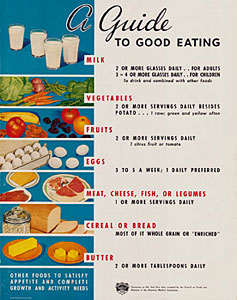
1941 Guide to Good EatingAES researchers had been studying the best type of freezer packaging and advocated freezing of vegetables because it let the “farmer” have more varied, palatable, and nutritious foods. This bulletin stated that glass containers were best for freezing and superior to paperboard containers or empty coffee cans. As for varieties, there wasn’t much difference except between white and yellow sweet corn; yellow froze better than white. (Knowles, et al, 1943)
By 1955, Ruth Dawson had quite a bit of experience in the study of freezing foods. She had been publishing on food preservation since 1939 and in 1955 published four circulars on freezing fruits and vegetables. She wrote that freezing preserves food by slowing the enzyme action and bacterial action on foods. Frozen foods retain more nutrients than canned foods and they retain their color, texture, and flavor. Spoilage was reduced compared to canned foods. Efficiency for the homemaker was a major advantage of freezing. Foods could be purchased at peak production thereby saving money; meals could be prepared more quickly; shopping was reduced in time (and car costs) because food was available in the home freezer. Preferred containers were glass, coffee cans, waxed cartons or tubs (but not milk cartons), plastic jars and boxes, or aluminum containers. Certain foods should not be frozen, such a lettuce, whole tomatoes, pears, celery, onions, peppers, and potatoes. (Circular A-231)
Her next bulletin is about the techniques of preparing foods to be frozen. She advised homemakers to push fruits down with a crushed “moisture proof material.” Use ascorbic or citric acid to prevent discoloration. Foods can be frozen in plastic coated freezer containers which look much like a one-pint ice cream box of a circular shape. Scald vegetables and cook squash before freezing. Freeze vegetables immediately after picking in order not to lose Vitamin C. (Circular A-234)




